Structure and Vehicle Containment
After fire, the first priority near a stream is to isolate the burned structures and vehicles with Best Management Practices (BMPs) such as straw wattles.
Before starting to work, Personal Protective Equipment (PPE) must be worn. PPE includes an N95 mask or respirator, eye protection, gloves, long sleeves and pants, sturdy work boots, and hat. Dust and debris are toxic and should not inhaled or touched.
The best way to isolate and keep these toxins stationary is to install straw wattles around the perimeter of the burned object, which trap the stormwater runoff and absorb the toxic sludge. Dig a shallow trench, on contour around the outer perimeter of the burned structure debris, placing the dug soil to the inside of the trench. Don’t dig through the ash. Instead, find a logical line just outside of the burned debris. The trench should only be a few inches deep and just wide enough to hold a straw wattle. The placement of the wattle should be as level as possible so that the water that goes into the trough does not run off to one side. Next, carefully place straw wattles into the trough, curving up on the ends and overlapping slightly so that there are no gaps for water to pass through. Stake it into the ground every 4 or 5 feet or so, depending on the slope, so that the wattle does not move. This will ensure that when rainfall starts moving particles of ash and toxins, the runoff water dips into that level trough, spreads laterally, and gets absorbed and filtered by the straw wattle.
When contractors come to remove all of the burned debris, these wattles should be pulled up and removed with the fire debris because they contain toxins. After the fire debris has been removed, throw down some mulch over the site. After testing soil to ensure that it is clean, more permanent erosion control measures can be installed.
Wear PPE – protect yourself from toxic ash and dust
Install Wattles – Slow down runoff and screen out toxins
Dispose of Wattles – keep toxins isolated
Cover with Mulch – protect clean soil from eroding
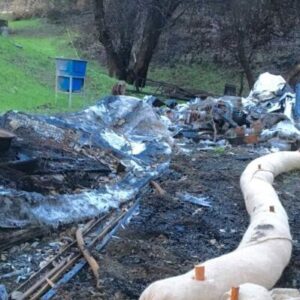
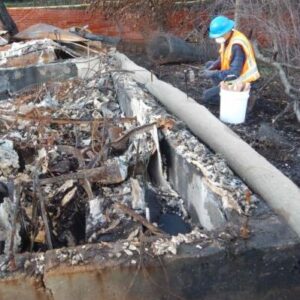
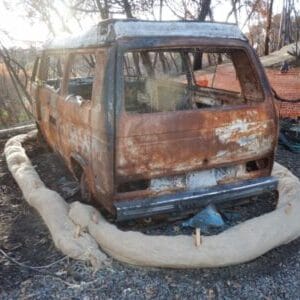

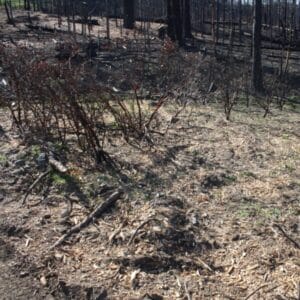
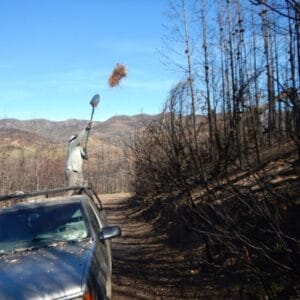
Bare Soil Stabilization
The best treatment for bare soil over a large area is to stay off the land as much as possible, and let nature take its course to recover. Hopefully, the rainy season will start off with frequent, low-intensity rains that sprout the native seeds and bulbs from the ground. Burned shrubs such as manzanita, chamise, and coyote brush will stump sprout from their bases and grow back, providing cover for the soil. Try not to to disturb plant roots because they are holding the soil together.
Stabilization is needed when extremely steep slopes, road cuts, above house sites, or above stream banks are exposed. Try to break down burned up or downed branches into low-lying woody debris, and spread evenly over the landscape. Loppers can be used to cut up the downed branches into smaller pieces that rest nicely on the ground. Carefully-placed, crushed branches with lots of contact with the soil will help slow down rill erosion (when the runoff forms little gullies straight down the hillside). Re-seeding can be problematic, and is not generally not suggested for natural hillsides.
If a chipper can be brought into the areas around homes and driveways, burned branches can be chipped into coarse mulch while taking care to aim the exit chute in many different directions to broadcast the chips over a large area. Only a very thin layer of no more than 1 to 2 inches and about 70% coverage is needed. This mulch helps to protect the bare soil from rain drop splatter erosion, and prevents rill erosion. The thin layer provides opportunities for native seeds to sprout, and gives the young plants better moisture retention to increase their chances of survival. If tree crews are working in the burn area, ask them to aim their chutes onto the hillside and regularly rotate the sprayed chips across the landscape so that it is not too thick. Another strategy, if the chipper can’t be positioned near the affected slope, is to chip the wood into one big pile on the side of a road or driveway that can be collected and spread by bucket brigade. Burn piles are an economical solution to removing the downed woody debris, but offer virtually no erosion control benefits.
If there is no burned wood available to broadcast or chip up, weed-free rice straw makes an effective erosion-control mulch. Rice straw breaks apart into slices that can be pulled apart and spread in a very thin layer. Rice straw tends to clump together, so it is important to painstakingly break apart these clumps. Too thick of an application will discourage native seeds from sprouting through. To avoid displacement in windy areas, tuck the straw into the ground with the tip of a shovel or use wood chips instead.
In certain critical slopes, jute netting fabric can be secured with wooden stakes over thinly-dispersed straw. The coarse weave of this fabric allows native plants to sprout up through it all and stabilize the soil. Incorporating a trenched-in wattle line further prevents erosion, particularly on bulldozer cuts, and above roads and homes.
Bulldozer Cuts
During the fire fight, bulldozers can be an effective tool to create fire breaks and prevent the fire from spreading. Unfortunately, these dozer cuts eliminate the vegetative cover and leave behind large areas of bare soil, often on steep slopes and near stream channels. The potential for erosion during the rainy season is high, but there are some treatments that can be effective in limiting the amount of sediment-laden stormwater from moving off the site and into our waterways. The fire agencies, usually CalFire, have resource advisors that develop recommendations for rehabilitation of these dozer cuts.
Fire Suppression Repair is a term for a series of immediate post-fire actions taken to repair damages and minimize potential soil erosion and impacts resulting from fire-suppression activities. This work usually begins before the fire is contained, and while the Incident Management Team is still mobilized in that area. This immediate rehabilitation includes actions such as re-grading problematic cuts and digging water bars into dozer lines to drain stormwater off of the bare soil and into the surrounding landscape.
We are left with several problems: bare soil that is deeply rutted with vehicle and bulldozer tracks, berms on both sides of the blades, very loose soil, and piles of uprooted vegetation. Our strategy is to focus on the ephemeral waterways in the canyon bottoms, and work our way up the hill as time an available resources allow. First, we use shovels and rakes to smooth out the major depressions and berms in the soil from equipment wheels and tracks, because these can act as accelerators of erosion down a slope. Some of the lateral tracks and berms that run across the hillside should remain, for they can help to act as check dams, slowing down the movement of water down the hill. Try to work with nature rather than fight it. If possible, cover the smoothed soil with mulch as described in the previous section. The large vegetation debris piles that get deposited by bulldozers can be useful material to cut up as mulch. Cutting up and spreading vegetation piles also improves the future soil health and lessens the fire hazard risk. Try not to use trucks or machinery on the dozer cuts, because that loose soil will get even more disturbed. Because much of the topsoil has been scraped away, there might not be much native seed bank in the dozer scars, so broadcasting native grass and wildflower seeds might be helpful near home sites and driveways before a good rainy season.
Bulldozers and work boots are notorious invasive plant seed spreaders, so remove any mustard, thistle, broom and other problematic plants that pop up to allow the natives to get re-established. Create foot paths to be used repeatedly for maintenance and weeding, and try to stay off the slopes when possible. Sometimes there are bulbs and root burls underground that will resprout if the grading was not too severe.
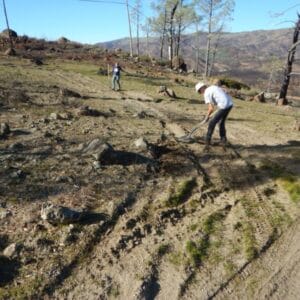
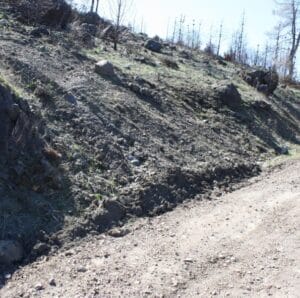
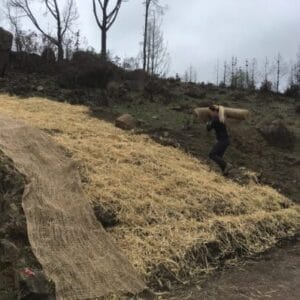
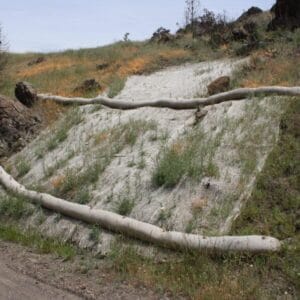
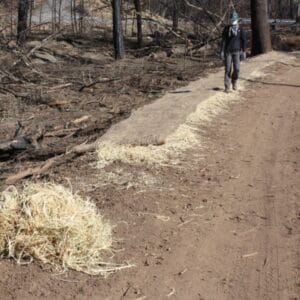
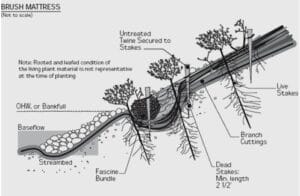
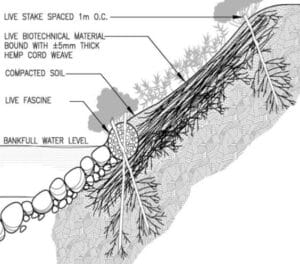
Creek Bank Stabilization
Stream channels are especially vulnerable after big fires. The burned uplands do not have the capacity to absorb heavy rainfall, and stormwater runoff can be higher here than in other areas. This strains on the stream channel’s soil retention capabilities and can lead to bank erosion, muddy debris flows, and flooding downstream.
We worked on Little Sulfur Creek following the Kincade Fire, in an area that was heavily impacted by heavy logging equipment adjacent to the floodplain of the creek. Fish and Game regulations prohibit shaping land within the stream channel itself, but we did have success with stabilizing the top of the bank along a dirt road. We smoothed out the equipment track marks, spread rice straw thinly, and covered with jute netting fabric. Along the edge of the fabric closest to the road, we used steel pins as anchors because the pins lie flush with the ground. In areas where there won’t be future vehicle or pedestrian traffic, wooden stakes are used because they are more biodegradable and economical. The native plants were able to sprout up through the straw and fabric, and remains quite stable, despite continued vehicle disturbances on the road. Woody debris and mulch were spread across the floodplain and will contribute to erosion control functions and increase the fertility of the soil.
In order to work on stabilizing a stream bank, we must consult various agencies to get permits to work within the riparian zone. We did this for our Windsor Creek bank stabilization project, where we used bioengineering techniques to rebuild a failed bank next to a dirt access road and homes. Bioengineering uses willow cuttings, large woody debris in the channel, and biodegradable fabric to create soil lifts and willow mattresses.
